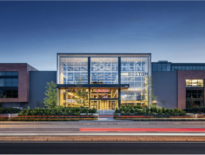Mike Doty
Senior Director, Originations New England/New York, Nuveen Green Capital
Age: 37
Years experience:12
Commercial landlords and developers face difficult decisions about how to finance sustainable building projects to control energy costs and comply with decarbonization regulations. Through its C-PACE [Commercial Property Assessed Clean Energy] program available in Massachusetts and 31 other states, Darien, Connecticut-based Nuveen Green Capital offers financing for multifamily construction and gut rehabs, solar and renewable installations and energy-efficiency upgrades. The firm, co-founded in 2015 by Jessica Bailey and Alexandra Cooley as Greenworks Lending, was acquired by TIAA in 2021. Michael Doty joined Nuveen Green Capital in 2019 after seven years as an energy efficiency specialist for Eversource.
Q: What effect have interest rate increases had on real estate investors’ ability to finance clean energy projects?
A: The volatility in the debt market has had a substantial impact, and certainly has constrained the number of deals getting done. Projects that were thinking about 4 percent or 5 percent permanent debt now have to consider 6 percent or 7 percent permanent debt. It creates a need for additional equity. That has caused a downward force on deal flow, but what has happened at the same time is it’s created additional opportunities for C-PACE, which is why our transaction volume has actually gone up.
The primary reason for that is the inversion in the yield curve. We generally price [in relation to] 10-year Treasuries. C-PACE is one of the lowest-cost forms of construction financing on the market. When you think about deal size and deal quality, the type of projects benefiting from C-PACE have increased over the past 12 months. For existing buildings, there is now a much more compelling use case for C-PACE even in low-leverage buildings. While our rates may be higher than their existing mortgage, they are equivalent to what they could get on a refinance. The blended cost of capital then comes in dramatically lower than a cash-out refi.
Q: Which property categories and types of projects are generating the most deal business?
A: It’s probably multifamily, hospitality and light industrial. It’s split between ground-up construction and recently completed projects, gut rehabilitations and adaptive reuse, and upgrading the core building systems.
Q: How is climate change generating demand for C-PACE funding?
A: There’s a really good demand in certain markets, Florida being one of them, on the hurricane and flood resiliency front. Maryland law has been updated to include resiliency, flood mitigation and drainage. New York City Local Law 97 and BERDO [Building Emissions Reduction and Disclosure Ordinance] in Boston are the two largest [regulatory] drivers, and we are starting to see more shovel-ready projects come to us. [In Boston] the first two are in the pipeline now: light industrial last-mile logistics near Logan Airport.
Q: How is the adoption of new energy codes in local jurisdictions affecting demand for C-PACE?
A: Stretch codes are being utilized in many markets as a qualification mechanism for C-PACE. They help both in providing a framework for what types of buildings qualify for this financing, but also in market adoption of those building practices. The communities that have opted into the specialized energy code in Massachusetts create a natural market for C-PACE. Additionally, I’m very excited about the opportunity from the Massachusetts Climate Bank that the governor announced this summer. We found in New York that the NY Green Bank is being a great catalyst of C-PACE projects. While there’s some increases that will be needed in scope and funding to catalyze projects, having that structure created is a great first step.
Q: How did your background at Eversource play into your transition to Nuveen Green Lending and current role?
A: I was with Eversource as an efficiency consultant, starting with the small business program in Connecticut, and moved on to run the upstream incentive programs both in Connecticut and Massachusetts. It became clear to me if we were going to have an impact from a deep energy retrofit and Net Zero design standpoint, repair dollars could only go so far. The backbone of the market was moving from ratepayer-funded incentives to a privately-funded environment, where our impact could be outsized relative to the public dollars invested.
Q: Which new technologies are gaining the most momentum and widespread adoption?
A: The newest commercially viable technology that we are seeing significant interest in is geothermal. The [Inflation Reduction Act] has significantly changed the math for geothermal installations. Heat pumps continue to accelerate, as well as any manner of building electrification, especially in markets with carbon cap legislation in place. Those are the big ones. Solar remains a good technology as well, although it’s maturing to a point where the hockey stick-level growth that we’ve seen is starting to shift to other technology.
Doty’s Five Favorite Sports Moments
- Kris Jenkins’ 2106 NCAA Championship buzzer-beater
- Villanova University’s 2019 national title win
- Aaron Boone’s 2003 American League Championship home run
- UConn vs. Syracuse sextuple-overtime Big East Tournament in 2009
- Jordan Spieth’s hole-out to win the 2017 Travelers Championship







